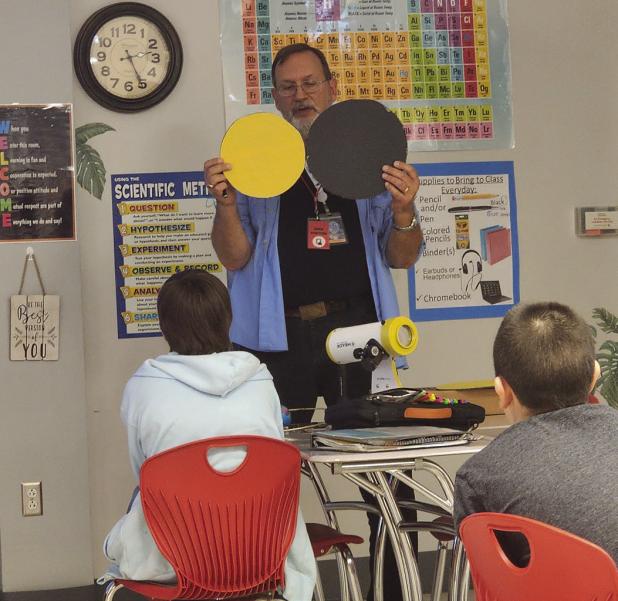
NASA ambassador Bernhardt schools OISD on eclipse
Science students at Olney Junior High School got a primer on how to safely enjoy the April 8 total eclipse from Armin Bernhardt, a NASA Partner Eclipse Ambassador, a cousin of the Olney Bernhardt family and an amateur astronomer in Wylie, Texas.
Mr. Bernhardt spent last Friday talking to students about the upcoming solar eclipse, which will turn the day to twilight for four minutes and 20 seconds as the moon completely blocks out the sun in the “area of totality” stretching from Mexico to Canada. The Earth is the only planet in our entire solar system that can experience this kind of a total solar eclipse like we will have on April 8th.
The eclipse begins at 12:21 p.m. and reaches maximum obscuration at 1:40 p.m., Mr. Bernhardt said. It will take the moon two hours and 38 minutes to move across the face of the sun, and the event will end at 3 p.m., he said.
It is the second time in seven years that Americans will witness a total solar eclipse, the last eclipse occurring in 2017. The United States will not see another total solar eclipse for 20 years, he said. The path of totality includes the Dallas-Fort Worth area, which will experience the darkening skies for four minutes and 27 seconds, he said. Olney will see a 96 percent eclipse, Mr. Bernhardt said. He stressed the importance of wearing special solar eclipse glasses while looking at the eclipse to avoid retinal damage from ultraviolet light. Only those in the path of totality can safely remove their glasses - and only then during the few moments when the moon completely obscures the sun, he said. Observers of the eclipse from Olney will require proper eye protection to view the eclipse during the entire eclipse event.
Mr. Bernhardt also warned students not to put binoculars or any other optical aid in front of the eclipse glasses, showing them the burn holes in the glasses that occur. He advised students to purchase glasses rated ISO 12312-2 or use #14 welders glasses, and to use a solar filter in front of any telescopes used to view the eclipse. He gave the school 175 pairs of the official solar eclipse glasses courtesy of the NASA Partner Eclipse Ambassador program.
He told students to expect multiple phenomena on the ground. “The wind shifts, the temperature drops, the crickets and cicadas start up,” he said. He also showed students a video he shot in Kentucky of the 2017 eclipse showing “shadow bands’ of faint, wavy light rays traveling across a white bed sheet on the ground and a 360-degree view of a “sunset” that occurred during totality. He also demonstrated how to build projector boxes to view the event.
“An eclipse doesn’t occur in the same spot – only about once every 375 years on average,” he said. “But that’s not totally true … Carbondale, Illinois will have an eclipse twice in seven years.”
Only 0.5 percent of the world’s population or 43 million people - live in the path of totality, according to The Planetary Society.
